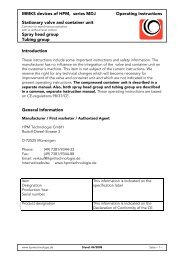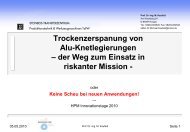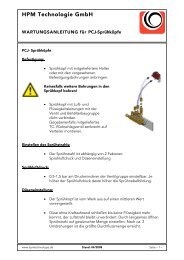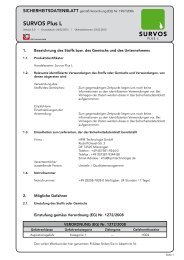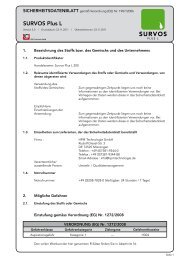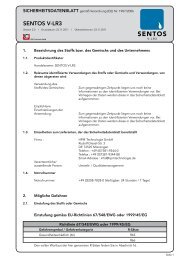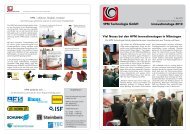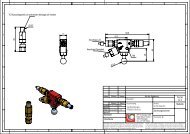SURVOS Plus L - hpmtechnologie.de
SURVOS Plus L - hpmtechnologie.de
SURVOS Plus L - hpmtechnologie.de
Create successful ePaper yourself
Turn your PDF publications into a flip-book with our unique Google optimized e-Paper software.
SAFETY DATA SHEET according to Regulation (EC) Nr. 1907/2006<br />
<strong>SURVOS</strong> <strong>Plus</strong> L<br />
Version 3.0 | Print Date: 23.11.2011 | Revision Date: 23.11.2011<br />
1. I<strong>de</strong>ntification of the substance/mixture and of the company/un<strong>de</strong>rtaking<br />
1.1. Product i<strong>de</strong>ntifier<br />
Tra<strong>de</strong> name: <strong>SURVOS</strong> <strong>Plus</strong> L<br />
1.2. Relevant i<strong>de</strong>ntified uses of the substance or mixture and uses advised against<br />
Use of the<br />
Substance/Mixture: At this time we do not yet have information on i<strong>de</strong>ntified uses.<br />
They will be inclu<strong>de</strong>d in this safety data sheet when available.<br />
Recommen<strong>de</strong>d<br />
restrictions on use: At this time we do not yet have information on i<strong>de</strong>ntified uses.<br />
They will be inclu<strong>de</strong>d in this safety data sheet when available.<br />
1.3. Details of the supplier of the safety data sheet<br />
Company: HPM Technologie GmbH<br />
Rudolf-Diesel-Str. 3<br />
DE 72525 Münsingen<br />
Telephone: +49 (0)7381-9344-0<br />
Telefax : +49 (0)7381-9344-88<br />
Email-address : info@<strong>hpmtechnologie</strong>.<strong>de</strong><br />
Responsible/<br />
issuing person: Umwelt- / Qualitätsmanagement<br />
1.4. Emergency telephone number<br />
Emergency telephone +49 (0)208-7828-0 Available 24h/7d<br />
number:<br />
2. Hazards i<strong>de</strong>ntification<br />
2.1. Classification of the substance or mixture<br />
Classification according to Regulation (EC) No 1272/2008<br />
REGULATION (EC) No 1272/2008<br />
Hazard class Hazard category Target Organs Hazard statements<br />
Aspiration hazard Category 1 --- H304<br />
For the full text of the H-Statements mentioned in this Section, see Section 16.<br />
Page 1
SAFETY DATA SHEET according to Regulation (EC) Nr. 1907/2006<br />
<strong>SURVOS</strong> <strong>Plus</strong> L<br />
Version 3.0 | Print Date: 23.11.2011 | Revision Date: 23.11.2011<br />
Classification according to EU Directives 67/548/EEC or 1999/45/EC<br />
Directive 67/548/EEC or 1999/45/EC<br />
Hazard symbol / Category of danger Risk phrases<br />
Harmful (Xn) R65<br />
R66<br />
For the full text of the R-phrases mentioned in this Section, see Section 16.<br />
Potential environmental See section 12 for environmental information.<br />
effects: No further information available.<br />
2.2. Label elements<br />
Labelling according to Regulation (EC) No 1272/2008<br />
Hazard symbols:<br />
Signal word: Danger<br />
Hazard statements: H304 May be fatal if swallowed and enters airways.<br />
Precautionary<br />
statements<br />
Response: P301 + P310 If swallowed: Immediately call a POISON CENTER or<br />
doctor/ physician.<br />
P331 Do not induce vomiting.<br />
Storage: P405 Store locked up.<br />
Disposal: P501 Dispose of contents/ container to an<br />
approved waste disposal plant.<br />
Additional Labelling:<br />
EUH066 Repeated exposure may cause skin dryness or cracking.<br />
Hazardous components which must be listed on the label:<br />
• Hydrocarbons, C10-C13, n-alkanes, isoalkanes, cyclics, < 2% aromatics<br />
• Hydrocarbons, C10-C13, isoalkanes, cyclics,
SAFETY DATA SHEET according to Regulation (EC) Nr. 1907/2006<br />
<strong>SURVOS</strong> <strong>Plus</strong> L<br />
Version 3.0 | Print Date: 23.11.2011 | Revision Date: 23.11.2011<br />
3. Composition/information on ingredients<br />
3.1. Mixtures<br />
Chemical nature: Hydrocarbon mixture<br />
For the full text of the R-phrases mentioned in this Section, see Section 16.<br />
For the full text of the H-Statements mentioned in this Section, see Section 16.<br />
4. First aid measures<br />
4.1. Description of first aid measures<br />
Amount [%] Hazard class /<br />
Hazard Category<br />
Hydrocarbons, C10-C13, n-alkanes, isoalkanes, cyclics, < 2% aromatics<br />
General advice: Move out of dangerous area. Take off all contaminated clothing<br />
immediately.<br />
If inhaled: Remove to fresh air. If symptoms persist, call a physician. If<br />
unconscious place in recovery position and seek medical<br />
advice.<br />
In case of skin contact: Wash off immediately with soap and plenty of water. If skin<br />
irritation persists, call a physician.<br />
In case of eye contact: In the case of contact with eyes, rinse immediately with plenty<br />
of water and seek medical advice.<br />
If swallowed: Do not induce vomiting. Risk of aspiration! Call a physician<br />
immediately. If a person vomits when lying on his back, place<br />
him in the recovery position.<br />
4.2. Most important symptoms and effects, both acute and <strong>de</strong>layed<br />
Hazard Statements Classification<br />
(67/548/EWG)<br />
EC-Nr.<br />
Registration<br />
: 918-481-9<br />
>= 50<br />
: 01-2119457273-39-xxxx<br />
Asp. Tox.1 H304 Xn; R65<br />
R66<br />
Hydrocarbons, C10-C13, isoalkanes, cyclics, = 50<br />
Classification<br />
(REGULATION (EC) No 1272/2008)<br />
Asp. Tox.1 H304 Xn; R65<br />
R66<br />
Symptoms: Symptoms of overexposure may be headache, dizziness,<br />
tiredness, nausea and vomiting. Inhalation can cause CNS-<br />
<strong>de</strong>pression and narcosis. Dries out the skin.<br />
Effects: Risk of serious damage to the lungs (by aspiration). Aspiration<br />
may cause pulmonary oe<strong>de</strong>ma and pneumonitis.<br />
Page 3
SAFETY DATA SHEET according to Regulation (EC) Nr. 1907/2006<br />
<strong>SURVOS</strong> <strong>Plus</strong> L<br />
Version 3.0 | Print Date: 23.11.2011 | Revision Date: 23.11.2011<br />
4.3. Indication of any immediate medical attention and special treatment nee<strong>de</strong>d<br />
Treatment: Treat symptomatically.<br />
5. Firefighting measures<br />
5.1. Extinguishing media<br />
Suitable extinguishing Water spray, foam, dry pow<strong>de</strong>r or CO2.<br />
Unsuitable extinguishing High volume water jet.<br />
media:<br />
5.2. Special hazards arising from the substance or mixture<br />
Specific hazards during Combustible liquid. Vapours may form explosive mixtures with<br />
<strong>de</strong>r Brandbekämpfung: air. The product is insoluble and floats on water. Incomplete<br />
combustion may form toxic pyrolysis products. Fire may cause<br />
evolution of: Carbon oxi<strong>de</strong>s.<br />
5.3. Advice for firefighters<br />
Special protective In the event of fire, wear self-contained breathing<br />
equipment for firefighters: apparatus.Wear appropriate body protection (full protective<br />
suit).<br />
Further information: Cool closed containers exposed to fire with water<br />
spray. Collect contaminated fire extinguishing water<br />
separately. This must not be discharged into drains.<br />
6. Acci<strong>de</strong>ntal release measures<br />
6.1. Personal precautions, protective equipment and emergency procedures<br />
Personal precautions: Use personal protective equipment. Provi<strong>de</strong> a<strong>de</strong>quate<br />
ventilation. Keep away from heat and sources of ignition. Avoid<br />
contact with skin and eyes. Do not breathe gas/fumes/<br />
vapour/spray.<br />
6.2. Environmental precautions<br />
Environmental precautions: Do not flush into surface water or sanitary sewer system. Avoid<br />
subsoil penetration. If the product contaminates rivers and<br />
lakes or drains inform respective authorities. If material reaches<br />
soil inform authorities responsible for such cases.<br />
6.3. Methods and materials for containment and cleaning up<br />
Methods and materials for Ensure a<strong>de</strong>quate ventilation. Absorb with liquid-binding<br />
containment and cleaning up: material (sand, diatomite, acid bin<strong>de</strong>rs, universal bin<strong>de</strong>rs). Treat<br />
Page 4
SAFETY DATA SHEET according to Regulation (EC) Nr. 1907/2006<br />
<strong>SURVOS</strong> <strong>Plus</strong> L<br />
Version 3.0 | Print Date: 23.11.2011 | Revision Date: 23.11.2011<br />
6.4. Reference to other sections<br />
For personal protection see section 8.<br />
7. Handling and storage<br />
7.1. Precautions for safe handling<br />
recovered material as <strong>de</strong>scribed in the section „Disposal<br />
consi<strong>de</strong>rations“.<br />
Advice on safe handling: Keep container tightly closed. Avoid inhalation of vapour or<br />
mist. Provi<strong>de</strong> sufficient air exchange and/or exhaust in work<br />
rooms.<br />
Hygiene measures: Take off all contaminated clothing immediately. Do not<br />
breathe gas/fumes/vapour/spray. Avoid contact with the skin<br />
and the eyes. Keep away from food, drink and animal feeding-<br />
stuffs. Smoking, eating and drinking should be prohibited in the<br />
application area. Wash hands before breaks and at the end of<br />
workday.<br />
7.2. Conditions for safe storage, including any incompatibilities<br />
Requirements for storage<br />
areas and containers: Keep in an area equipped with solvent resistant flooring.Keep<br />
containers tightly closed in a dry, cool and well-ventilated place.<br />
Advice on protection<br />
against fire and explosion: Combustible liquid; Possible formation of ignitable mixtures in<br />
air if heated above flash point and/or if sprayed (atomised).<br />
Handle only at temperatures at least 15°C below the flash<br />
point. Keep away from sources of ignition - No smoking. Take<br />
measures to prevent the build up of electrostatic charge.<br />
Further information on<br />
storage conditions: Keep away from heat. Keep away from direct sunlight.<br />
Advice on common storage: Incompatible with oxidizing agents.<br />
German storage class: 10 Combustible Liquids<br />
7.2. Specific end uses<br />
Specific use(s): No information available.<br />
Page 5
SAFETY DATA SHEET according to Regulation (EC) Nr. 1907/2006<br />
<strong>SURVOS</strong> <strong>Plus</strong> L<br />
Version 3.0 | Print Date: 23.11.2011 | Revision Date: 23.11.2011<br />
8. Exposure controls/personal protection<br />
8.1. Control parameters<br />
Component: C9-C15 Aliphatics<br />
Other OELs<br />
TRGS 900, AGW:<br />
600 mg/m3, (2(II))<br />
Hydrocarbon mixtures, application as solvent (hydrocarbon solvent), additive-free<br />
8.2. Exposure controls<br />
Engineering measures<br />
Personal protective equipment<br />
Respiratory protection<br />
Advice: Required, if exposure limit is excee<strong>de</strong>d (e.g. OEL). In case of<br />
intensive or longer exposure use self-contained breathing<br />
apparatus. In case of brief exposure or low pollution use<br />
breathing filter apparatus. Recommen<strong>de</strong>d Filter type:<br />
Combination filter: A-P2<br />
Hand protection<br />
Advice: Solvent-resistant gloves Take note of the information given<br />
by the producer concerning permeability and break through<br />
times, and of special workplace conditions (mechanical strain,<br />
duration of contact). Protective gloves should be replaced at<br />
first signs of wear. The following materials are suitable:<br />
Material: Nitrile rubber<br />
Break through time: >=480 min<br />
Glove thickness: 0,45 mm<br />
Eye protection<br />
Advice: Tightly fitting safety goggles.<br />
Skin and body protection<br />
Advice: Protective work clothing<br />
Environmental exposure controls<br />
General advice: Do not flush into surface water or sanitary sewer system.<br />
Avoid subsoil penetration.<br />
If the product contaminates rivers and lakes or drains inform<br />
respective authorities.<br />
If material reaches soil inform authorities responsible for such<br />
cases.<br />
Page 6
SAFETY DATA SHEET according to Regulation (EC) Nr. 1907/2006<br />
<strong>SURVOS</strong> <strong>Plus</strong> L<br />
Version 3.0 | Print Date: 23.11.2011 | Revision Date: 23.11.2011<br />
9. Physical and chemical properties<br />
9.1. Information on basic physical and chemical properties<br />
Form: liquid<br />
Colour: colourless<br />
Odour: hydrocarbon-like<br />
Odour Threshold: no data available<br />
pH: not applicable<br />
Melting point/range: < -20 °C<br />
Boiling point/boiling range: 160 - 260 °C<br />
Flash point: > 61 °C<br />
Evaporation rate: 0,04 (Butyl Acetate = 1)<br />
Flammability (solid, gas): The product is flammable but not readily ignited.<br />
Upper explosion limit: 7 %(V)<br />
Lower explosion limit: 0,5 %(V)<br />
Vapour pressure: ca. 0,6 hPa (25 °C)<br />
Relative vapour <strong>de</strong>nsity: > 1 (Air = 1.0)<br />
Density: 0,72 - 0,85 g/cm3 (15 °C)<br />
Water solubility: (20 °C) not respectively poorly mixable<br />
Partition coefficient: no data available<br />
Ignition temperature: > 200 °C<br />
Thermal <strong>de</strong>composition: no data available<br />
Viscosity, kinematic: 1,0 - 2,5 mm2/s (20 °C)<br />
Explosivity: Formation of explosive air/vapour mixtures is possible.<br />
Oxidizing properties: None known.<br />
9.2. Other information<br />
No further information available.<br />
Page 7
SAFETY DATA SHEET according to Regulation (EC) Nr. 1907/2006<br />
<strong>SURVOS</strong> <strong>Plus</strong> L<br />
Version 3.0 | Print Date: 23.11.2011 | Revision Date: 23.11.2011<br />
10. Stability and reactivity<br />
10.1. Reactivity<br />
Advice: No <strong>de</strong>composition if stored and applied as directed.<br />
10.2. Chemical stability<br />
Advice: Stable un<strong>de</strong>r recommen<strong>de</strong>d storage conditions.<br />
10.3. Possibility of hazardous reactions<br />
Hazardous reactions: Formation of explosive air/vapour mixtures is possible.<br />
10.4. Conditions to avoid<br />
Conditions to avoid: Heat, flames and sparks.<br />
Thermal <strong>de</strong>composition: no data available.<br />
10.5. Incompatible materials<br />
Materials to avoid: Strong oxidizing agents<br />
10.6. Hazardous <strong>de</strong>composition products<br />
Hazardous <strong>de</strong>composition Fire may cause evolution of: Carbon oxi<strong>de</strong>s, Un<strong>de</strong>r<br />
products: certain fire conditions, traces of other toxic products<br />
cannot be exclu<strong>de</strong>d.<br />
11. Toxicological information<br />
11.1. Information on toxicological effects<br />
Irritation<br />
Result: Prolonged skin contact may <strong>de</strong>fat the skin and produce <strong>de</strong>rmatitis.<br />
Skin<br />
Eyes<br />
Result: Causes discomfort in the eyes but does not harm eye-tissue.<br />
Sensitisation<br />
Result: No sensitizing effect known.<br />
Experience with human<br />
exposure:<br />
Further information<br />
Even smallest amounts of product may cause pulmonary e<strong>de</strong>ma or pneumonia<br />
when absorbed into the lungs by swallowing or subsequent vomiting.<br />
Page 8
SAFETY DATA SHEET according to Regulation (EC) Nr. 1907/2006<br />
<strong>SURVOS</strong> <strong>Plus</strong> L<br />
Version 3.0 | Print Date: 23.11.2011 | Revision Date: 23.11.2011<br />
Component: Hydrocarbons, C10-C13, n-alkanes, isoalkanes, cyclics, < 2% aromatics<br />
Acute toxicity<br />
LD50 > 5000 mg/kg (rat)<br />
Data based on test results or data from a comparable product.<br />
Inhalation<br />
LC50 > 4951 mg/l (rat; vapour)<br />
Data based on test results or data from a comparable product.<br />
Dermal<br />
LD50 > 5000 mg/kg (rabbit)<br />
Data based on test results or data from a comparable product.<br />
Component: Hydrocarbons, C10-C13, isoalkanes, cyclics, 5000 mg/kg (rat) (OECD Test Gui<strong>de</strong>line 401)<br />
Aspiration may cause pulmonary oe<strong>de</strong>ma and pneumonitis.<br />
Inhalation<br />
LC50 > 5 mg/l (rat) (OECD Test Gui<strong>de</strong>line 403)<br />
Inhalation may cause central nervous system effects.<br />
Dermal<br />
LD50 > 5000 mg/kg (rat) (OECD Test Gui<strong>de</strong>line 402)<br />
Page 9
SAFETY DATA SHEET according to Regulation (EC) Nr. 1907/2006<br />
<strong>SURVOS</strong> <strong>Plus</strong> L<br />
Version 3.0 | Print Date: 23.11.2011 | Revision Date: 23.11.2011<br />
12. Ecological information<br />
12.1. Toxicity<br />
Component: Hydrocarbons, C10-C13, n-alkanes, isoalkanes, cyclics, < 2% aromatics<br />
Acute toxicity<br />
LL0 1000 mg/l (Oncorhynchus mykiss (rainbow trout); 96 h) (Toxicity to fish)<br />
Fish<br />
Toxicity to daphnia and other aquatic invertebrates.<br />
EL0 1000 mg/l (Daphnia magna (Water flea); 48 h) (Toxicity to daphnia)<br />
algae<br />
EL0 1000 mg/l (Pseudokirchneriella subcapitata (green algae); 72 h)<br />
(Toxicity to algae)<br />
Chronic toxicity<br />
Fish<br />
NOELR 0,10 mg/l (Oncorhynchus mykiss (rainbow trout); 28 d)<br />
Aquatic invertebrates<br />
NOELR 0,18 mg/l (Daphnia magna (Water flea); 21 d)<br />
Component: Hydrocarbons, C10-C13, isoalkanes, cyclics, 1000 mg/l (Freshwater fish; 96 h) (Toxicity to fish; OECD Test<br />
Gui<strong>de</strong>line 203)<br />
Toxicity to daphnia and other aquatic invertebrates.<br />
EL50 > 1000 mg/l (Daphnia magna; 48 h) (Toxicity to daphnia; OECD Test<br />
Gui<strong>de</strong>line 202)<br />
algae<br />
EL50 > 1000 mg/l (Pseudokirchneriella subcapitata (green algae); 72 h)<br />
(Toxicity to algae; OECD Test Gui<strong>de</strong>line 201)<br />
Chronic toxicity<br />
NOELR 0,088 mg/l (fish; 28 d)<br />
Fish<br />
Fish<br />
Aquatic invertebrates<br />
NOELR 0,026 mg/l (Daphnia magna (Water flea); 21 d)<br />
Page 10
SAFETY DATA SHEET according to Regulation (EC) Nr. 1907/2006<br />
<strong>SURVOS</strong> <strong>Plus</strong> L<br />
Version 3.0 | Print Date: 23.11.2011 | Revision Date: 23.11.2011<br />
12.2. Persistence and <strong>de</strong>gradability<br />
Persistence and <strong>de</strong>gradability<br />
Bio<strong>de</strong>gradability<br />
Result: The product is insoluble and floats on water.<br />
The product evaporates slowly.<br />
Bio<strong>de</strong>gradability<br />
Result: 80 % (Exposure Time: 28 d)<br />
Readily bio<strong>de</strong>gradable.<br />
12.3. Bioaccumulative potential<br />
Result: no data available<br />
12.4. Mobility in soil<br />
Bioaccumulation<br />
Mobility<br />
Result: The product is insoluble and floats on water.<br />
12.5. Results of PBT and vPvB assessment<br />
Results of PBT and vPvB assessment<br />
Result: This mixture contains no substance consi<strong>de</strong>red to be persistent, bio-<br />
accumulating nor toxic (PBT). This mixture contains no substance<br />
consi<strong>de</strong>red to be very persistent nor very bioaccumulating (vPvB).<br />
12.6. Other adverse effects<br />
Additional ecological information<br />
Result: Do not flush into surface water or sanitary sewer system. Harmful to aquatic<br />
organisms, may cause long-term adverse effects in the aquatic environment.<br />
13. Disposal consi<strong>de</strong>rations<br />
13.1. Waste treatment methods<br />
Product: Disposal together with normal waste is not allowed. Do not let<br />
product enter drains. Can be incinerated, when in compliance<br />
with local regulations.<br />
Contaminated packaging: Empty remaining contents. Risk of explosion. Do not burn, or<br />
use a cutting torch on, the empty drum. Empty containers<br />
should be taken to an approved waste handling site for<br />
Page 11
SAFETY DATA SHEET according to Regulation (EC) Nr. 1907/2006<br />
<strong>SURVOS</strong> <strong>Plus</strong> L<br />
Version 3.0 | Print Date: 23.11.2011 | Revision Date: 23.11.2011<br />
recycling or disposal. Packagings that cannot be cleaned are to<br />
be disposed of in the same manner as the product.<br />
European Waste Catalogue Number: No waste co<strong>de</strong> according to the European Waste Catalogue<br />
can be assigned for this product, as the inten<strong>de</strong>d use dictates<br />
the assignment. The waste co<strong>de</strong> is established in consultation<br />
with the regional waste disposer.<br />
14. Transport information<br />
Not dangerous goods for ADR, RID and IMDG.<br />
14.1. UN number<br />
Not applicable.<br />
14.2. UN proper shipping name<br />
Not applicable.<br />
14.3. Transport hazard class(es)<br />
Not applicable.<br />
14.4. Packaging group<br />
Not applicable.<br />
14.5. Environmental hazards<br />
Not applicable.<br />
14.6. Special precautions for user<br />
Not applicable.<br />
14.7. Transport in bulk according to Annex II of MARPOL 73/78 and the IBC Co<strong>de</strong><br />
IMDG: Not applicable.<br />
15. Regulatory information<br />
15.1. Safety, health and environmental regulations/legislation specific for the substance<br />
or mixture<br />
WKG (DE): WGK I<strong>de</strong>ntification Number: 27; WGK:1; slightly water<br />
endangering; WGK (DE); Classification according VwVwS of<br />
17 May 1999, Annex 2<br />
Page 12
SAFETY DATA SHEET according to Regulation (EC) Nr. 1907/2006<br />
<strong>SURVOS</strong> <strong>Plus</strong> L<br />
Version 3.0 | Print Date: 23.11.2011 | Revision Date: 23.11.2011<br />
Major Acci<strong>de</strong>nt Hazard 13 Falls un<strong>de</strong>r the German StörfallV.<br />
Legislation:<br />
Other regulations: Occupational restrictions: Take note of Dir 92/85/EEC on the<br />
safety and health of pregnant workers at work and of<br />
Dir 94/33/EC on the protection of young people at work.<br />
15.2. Chemical Safety Assessment<br />
Currently we do not have any Information from our supplier about this.<br />
16. Other information<br />
Full text of R-phrases referred to un<strong>de</strong>r sections 2 and 3.<br />
R65 Harmful: may cause lung damage if swallowed.<br />
R66 Repeated exposure may cause skin dryness or cracking.<br />
Full text of H-Statements referred to un<strong>de</strong>r sections 2 and 3.<br />
H304 May be fatal if swallowed and enters airways.<br />
Further information<br />
Other information: The information provi<strong>de</strong>d in this Safety Data Sheet is correct to<br />
our knowledge at the date of its revision. The information given<br />
only <strong>de</strong>scribes the products with regard to safety arrangements<br />
and is not to be consi<strong>de</strong>red as a warranty or quality<br />
specification and does not constitute a legal relationship.<br />
The information contained in this Safety Data Sheet relates only<br />
to the specific material <strong>de</strong>signated and may not be valid for<br />
such material used in combination with any other material or in<br />
any process, unless specified in the text.<br />
Page 13



